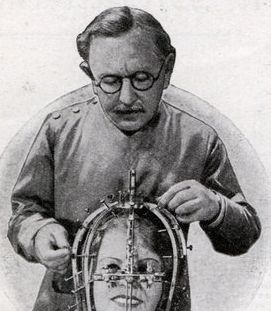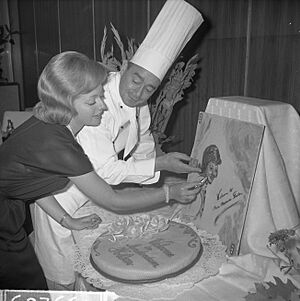Max Factor Sr. facts for kids
Quick facts for kids
Max Factor Sr.
|
|
|---|---|

Max Factor Sr. in 1935, demonstrating his beauty micrometer device
|
|
| Born |
Maksymilian Faktorowicz
September 15, 1877 Zduńska Wola, Congress Poland, Russian Empire
|
| Died | August 30, 1938 (aged 60) |
| Resting place | Hillside Memorial Park Cemetery, Culver City, California, U.S. |
| Monuments | Hollywood Walk of Fame |
| Nationality | Polish |
| Citizenship | American (naturalized) |
| Occupation | Entrepreneur; wig and cosmetics technician; inventor |
| Years active | 1887–1938 |
| Known for | Max Factor Cosmetics |
| Spouse(s) |
|
| Children | 5, including Francis "Frank" Factor (Max Factor Jr.) |
| Relatives |
|
| Awards | Honorary Academy Award (1929) |
Max Factor Sr. (born Maksymilian Faktorowicz on September 15, 1877 – died August 30, 1938) was a Polish-American businessman and inventor. He founded the famous cosmetics company Max Factor & Company. He played a huge role in creating the modern cosmetics industry in the United States. He also helped make the word "make-up" popular for everyday use.
Max Factor was known for giving movie stars their special looks. He created Jean Harlow's famous platinum blonde hair. He also designed Clara Bow's bob haircut and Joan Crawford's unique "Hunter's Bow" lip shape. He even helped Lucille Ball with her false eyelashes and red curls.
Contents
Early Life and Beginnings
Max Factor was born in Zduńska Wola, Poland. His family was of Polish-Jewish descent. His father worked hard, but could not afford to send his four children to school.
Max started working very young. At eight years old, he helped a dentist and a pharmacist. When he was nine, he became an apprentice to a wig maker and cosmetician in Łódź, Poland. This experience helped him get a job at Anton's of Berlin, a top hairstylist. By age fourteen, he worked at Korpo in Moscow. This company made wigs and cosmetics for the Imperial Russian Grand Opera.
Max then served in the Imperial Russian Army for four years. After his military service, he opened his own shop in Ryazan. He sold items he made himself, like rouge, creams, fragrances, and wigs. He became well-known when a traveling theater group used his cosmetics for a show for Russian royalty.
Becoming a Royal Expert
The Russian royal family was so impressed that they made Max Factor their official cosmetics expert. He also worked for the Imperial Russian Grand Opera. This honor meant he was watched closely by the authorities.
Max married Esther Rosa, whom he called Lizzie. By 1904, they had three children: Freda, Cecilia, and Davis. They worried about the growing anti-Jewish actions in the Russian Empire. So, they decided to move to America to join his brother and uncle. Max managed to leave his royal service. He and his family traveled in the steerage class on a ship and arrived at Ellis Island in New York on February 25, 1904. They settled in St. Louis, Missouri.
Starting a New Life in America
In 1904, Max Factor sold his rouges and creams at the World's Fair in St. Louis. He used the name Max Factor for the first time. Sadly, his business partner stole all his products and money. With help from his family, Max recovered and opened a barber shop.
In August 1904, Max and Lizzie had their fourth child, Francis "Frank" Factor. But on March 17, 1906, Lizzie sadly passed away. Max wanted a mother for his four children, so he married Huma "Helen" Sradkowska in August 1906. They had a son named Louis. However, this marriage did not last long. Max gained custody of all his children after a court case.
Building a Cosmetics Empire
On January 21, 1908, Max Factor married Jennie Cook. Later that year, he moved his family to Los Angeles, California. He saw a great chance to make custom wigs and theater make-up for the growing film industry. He opened a shop called "Max Factor's Antiseptic Hair Store."
In 1909, he founded "Max Factor & Company." He soon became a main seller of theatrical make-up on the West Coast. At that time, actors used thick greasepaint sticks, which didn't look good on camera. The colors were also not right for early movies.
Max Factor began to experiment with different ingredients. He wanted to create make-up that worked well for films. By 1914, he had made the first cosmetic specifically for movies. It was a thinner cream greasepaint, sold in a jar, and came in 12 different shades. Unlike old theater make-up, it did not crack or look caked on.
With this invention, Max Factor became the expert in film cosmetics. Movie stars wanted to try his "flexible greasepaint." Film producers also wanted his human hair wigs. He even let producers rent his expensive wigs for old Westerns. But only if his sons could have small parts in the movies to watch over the wigs.
In the 1920s, Max Factor started selling his cosmetics to the public. He promised that any girl could look like a movie star using Max Factor products.
Working with Movie Stars
In the early days of his business, Max Factor personally applied his products to actors and actresses. He was known for being able to create custom make-up that made stars look their best on screen. Many famous clients visited his beauty salon near Hollywood Boulevard. These included Gloria Swanson, Mary Pickford, Jean Harlow, Lucille Ball, and Judy Garland. Max Factor's name often appeared in movie credits, and he even had small acting roles himself.
Max Factor became a United States citizen in 1912.
In 1920, his son Frank suggested a change. Max Factor officially started calling his products "make-up." Before this, people used the word "cosmetics." "Make-up" was thought to be only for theater performers or people with a bad reputation. Max Factor helped change this idea.
Later Life and Legacy
In 1938, Max Factor was traveling in Europe with his son, Davis. While in Paris, he received a note demanding money for his safety. The police tried to catch the person, but no one showed up. Max Factor was very shaken by this threat. A doctor told him to return to the US, where he became ill.
Max Factor passed away on August 30, 1938, at 60 years old, in Beverly Hills, California. He was buried in Hillside Memorial Park Cemetery in Culver City.
Honors and Tributes
The Academy of Motion Picture Arts and Sciences gave Max Factor an honorary Academy Award in 1929. This was for his important contributions to the film industry. He also has a star on the Hollywood Walk of Fame at 6922 Hollywood Boulevard.
Max Factor is even mentioned in the classic song, "Hooray For Hollywood." The song says, "To be an actor / See Mr. Factor / He'll make your pucker look good!" This refers to how he created Clara Bow's heart-shaped lips.
Family Life
Max Factor had six children:
- Freda Shore (1898–1988)
- Cecilia Firestein (1899–1984)
- Davis Factor (1902–1991)
- Francis "Frank" Factor (later known as Max Factor Jr.; 1904–1996)
- Louis Factor (1907–1975)
- Sidney B. Factor (1916–2005)
His great-great-grandson, Amit L. Kochavi, is also an entrepreneur. He is continuing the family's tradition of innovation.


